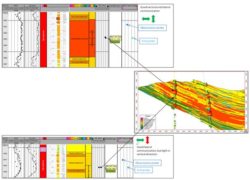The demand from our clients has shifted from holistic full-field models (“resource models”) to models where a specific objective is addressed (“decision models”).
The approach to geological modelling is evolving. The demand from our clients has shifted from holistic full-field models (“resource models”) to models where a specific objective is addressed (“decision models”). The latter models focus on the most key factors that have an impact on the decision to be made, and the key factors are determined by a cross disciplinary team.
Decision models are required for all stages in the development chain from appraisal through development to production. They may undertake advanced modelling techniques and workflows, but they most often turn out to be simpler, smaller and more transparent than resource models that are built using standard workflows and acknowledging “all” data available.
When AGR’s Reservoir Management & Subsurface team is assigned a modelling study, often as part of a larger study, our team will engage with the client on some key questions before starting: What will the model be used for? Is there a specific decision(s) that the model will guide? What are the key factors, e.g.: What level of resolution is required to make the decision? What is the most important uncertainty for the decision? Which heterogeneities to focus on? How much detail do we need to conclude with confidence? How many scales need to be employed in the model and should it be upscaled? And of course, how does it fit with overall study objectives, schedule and timeline, what are the deliverables and deadlines.
Experience in constructing decision models is something our team has plenty of and the following is a brief summary of some recent ones:
Decision in the exploration/redevelopment phase
AGR’s Reservoir Management & Subsurface was engaged by a Client to guide a “DG0” decision on an oil discovery located in a fairly flat circular structure in a fluvio-deltaic reservoir. A reservoir model was required in order to provide a reliable range of oil volumes and production profiles, and to support further evaluation of development concept including wells, facilities, flow assurance and tie-in possibilities. In the context of the overall study scope and level of decision to be made it was agreed that a coarse reservoir model would be sufficient and that the geological model wouldn’t require a high degree of detail. Hence structural, facies and property modelling was set up in an easily repeatable workflow for stochastic uncertainty analysis, see Figure 1.

Figure 1: Facies and property modelling; from well logs to model as a basis for static and dynamic uncertainty analysis workflow, assisting a client in a field development study.
This resulted in a reliable and realistic range of volumes that were key in guiding the access decision.
Decision in the appraisal stage
AGR was engaged by a Client to carry out a reservoir study on a recent discovery. The main objective was to give input to test planning and aid the decision whether or not to perform a production test on the temporily PA’d discovery well. A secondary objective was to achieve an outcome space and critical parameters for further development of the discovery.
Excellent reservoir sand was found in distributary channels in a marginal marine setting with tidal influence. One key question to be answered was if and how a possible test could reveal geological information such as geometry and properties of baffles/barriers in the reservoir. The team understood at an early stage that the key factors were reservoir heterogeneities such as thickness, lengths, abundance of shaly layers and that it would be important to run sensitivities on kv/kh in several geological scenarios. This enabled us to be more pragmatic on e.g the fault model and establishing a detailed geological concept for the facies model.
A near wellbore sector model with reduced grid cell size was constructed for the production test simulations. Detailed analysis from MDT pressure build-up gave information about lateral and vertical communication for each of the pressure tests. We plotted the precise depths of the sink probes and the observation probes which enabled linking communication to the geological facies from the core description log and the facies log used in the modelling. Such examples as in Figure 2 gave valuable information for sensitivities of Kv/Kh values per modelled facies in the detailed sector model. It provided a reliable tool to predict the dynamic behaviour of a possible production test and demonstrate to what extent one could expect to see baffles and barriers in the reservoir.

Figure 2: Relating detailed information about vertical and lateral communication from MDT pressure tests to facies. Note the exact depths of the sink/observation probes and the relation to scale in core plugs, core description and facies log used in modelling
Decision in a CO2 storage feasibility project
AGR was engaged by a Client in a CO2 storage feasibility study in the DG1 phase. Key questions to be addressed were related to the injectivity of CO2, plume migration, storage and leaking potential of CO2. For the modelling it was agreed that it would be critical to construct a reservoir model that could predict the pressure history and depletion in the area. A regional geological model was constructed to support this, combining data from a nearby detailed full field model with regional surfaces and sparse exploration well data. The main issue in this study was not the whole uncertainty range but the upper margins of pressure and temperature for an evaluation of the potential and risks. The geological model needed to be coarse. The permeability on a regional scale, together with geometry and communication between layers and fault ramp zones were shown to be key uncertainty factors to predict the possible flux of CO2. The model was used for simulation sensitivities and guided the decision to proceed with the CO2 project though the DG1 decision gate.
In all of these examples of recent geological modelling projects we have been conscious to focus on the main objective, the key factors, and to not complicate the workflows, modelling techniques and steps. This has also allowed our Clients to reproduce the models with tidy workflows. Our workflows were also prepared for uncertainty evaluations, either by stochastic methods or in a scenario-based deterministic approach. And last but not least, the models were suited to answer the most important issues in order to guide the decision to be taken.
Our view on trends in geological modelling
With regards to modelling techniques they have in many ways been similar for decades. Most times we base our models on constructing a grid which is designed to, and constrained by, the flow simulation needs. Quite often we experience that compromise of geological concepts and representing details at small scales have to be done.
These kinds of compromises can be dealt with by applying the well established principles of multi-scale modelling. Further trends go in the direction of grid-independent ways of modelling, surface based or process based, where the geological surfaces and/or processes are “static” and the grid is custom for each simulation purpose.
While these concepts and ideas are exciting and mind-inspiring, the established methodologies should be adequate for most modelling projects as long as we are conscious of the objectives, the key factors and what decision the model is supposed to guide.
We have described how the demand from our clients to some extent has shifted from holistic full-field models to decision models where a specific objective is addressed, what these decision models constitute as well as summarised some examples of recent decision modelling projects that AGR has undertaken. We have stated and argued that for these models we would rather simplify than overcomplicate the modelling techniques and workflows.



